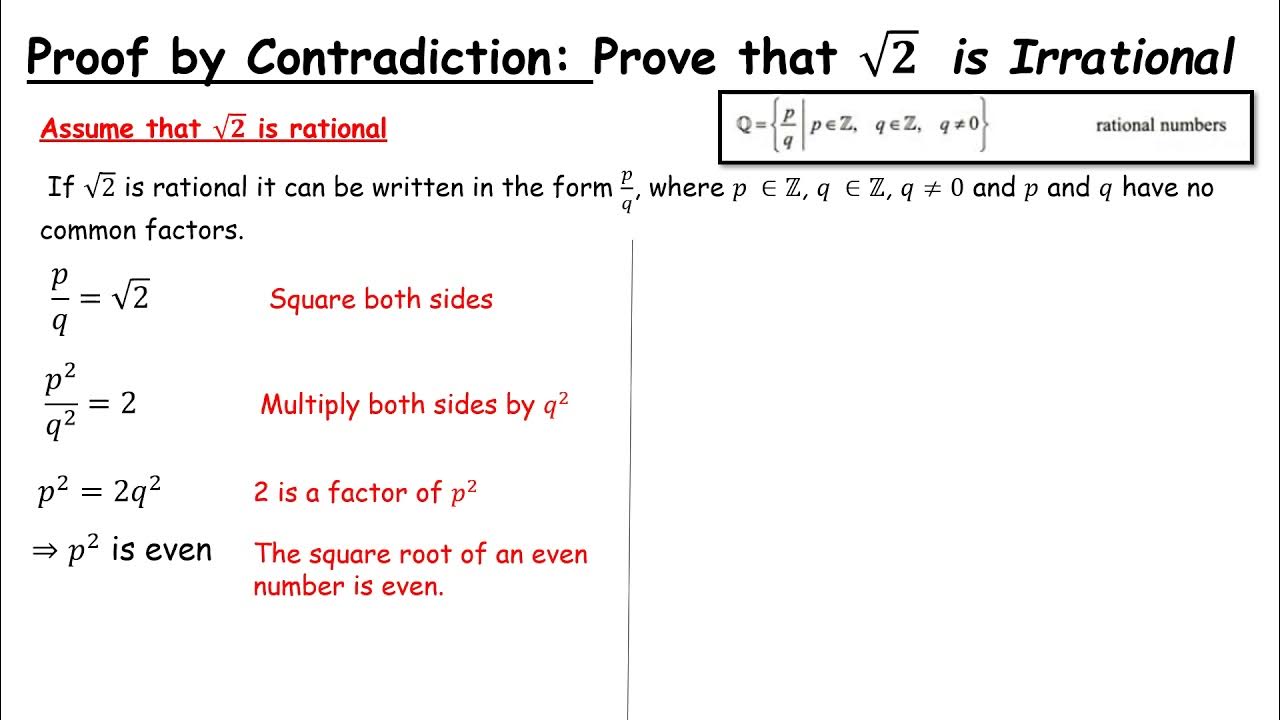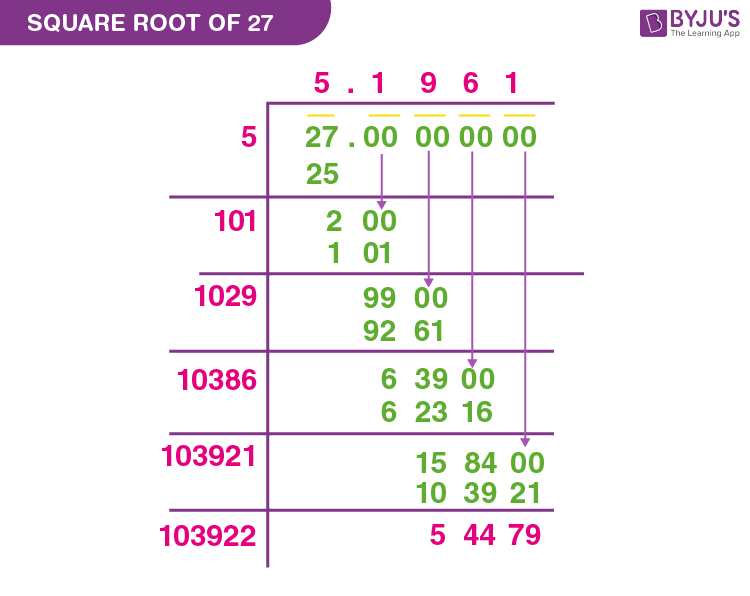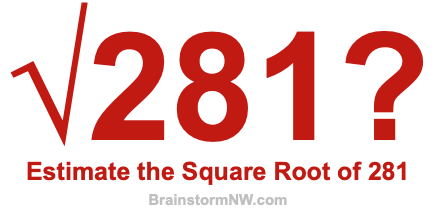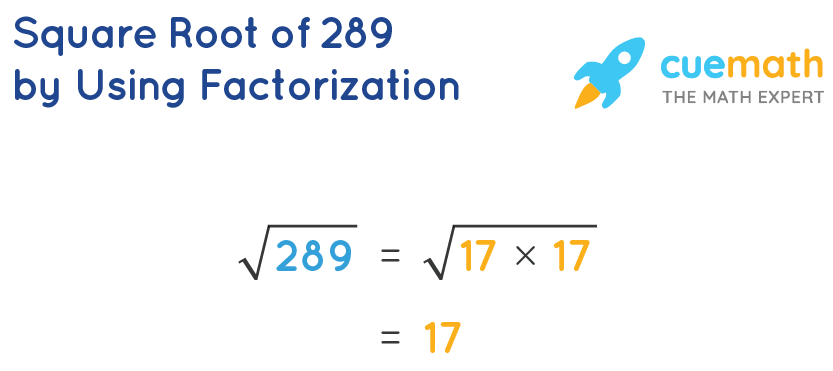Topic prove square root of 2 is irrational by contradiction: Discover the fascinating proof that the square root of 2 is irrational through contradiction. This article will guide you through each logical step, providing clear explanations and insights into why this classic proof remains a cornerstone of mathematical understanding. Perfect for students, educators, and anyone with a passion for math!
Table of Content
- Proof that the Square Root of 2 is Irrational by Contradiction
- Introduction
- Understanding Rational and Irrational Numbers
- Overview of Proof by Contradiction
- Assuming the Square Root of 2 is Rational
- Setting Up the Equation
- Squaring Both Sides
- Analyzing the Parity of a and b
- Substituting and Simplifying
- Identifying the Contradiction
- Conclusion: Square Root of 2 is Irrational
- Historical Context and Importance
- Applications of Irrational Numbers
- Common Misconceptions
- Further Reading and Resources
- YOUTUBE: Video chứng minh rằng căn bậc hai của 2 là số vô tỉ. Hãy khám phá cách chứng minh bằng phương pháp phản chứng.
Proof that the Square Root of 2 is Irrational by Contradiction
We will prove that the square root of 2 is irrational using a proof by contradiction. This method assumes that the square root of 2 is rational and then derives a contradiction from this assumption.
Step-by-Step Proof
- Assume that \(\sqrt{2}\) is rational. This means that it can be written as a fraction of two integers \( \frac{a}{b} \) where \( a \) and \( b \) are coprime (i.e., their greatest common divisor is 1).
- Write the assumption as an equation:
\(\sqrt{2} = \frac{a}{b}\)
- Square both sides of the equation to eliminate the square root:
\(2 = \frac{a^2}{b^2}\)
- Multiply both sides by \( b^2 \) to get rid of the denominator:
- Notice that \(a^2\) is even (because it equals \(2b^2\), which is even). Therefore, \(a\) must also be even (since the square of an odd number is odd).
- Let \(a = 2k\) for some integer \(k\). Substitute \(2k\) for \(a\) in the equation \(2b^2 = a^2\):
\(2b^2 = (2k)^2\)
\(2b^2 = 4k^2\)
- Divide both sides by 2:
\(b^2 = 2k^2\)
- This implies that \(b^2\) is even, and hence \(b\) must also be even.
- If both \(a\) and \(b\) are even, they have a common factor of 2. This contradicts the assumption that \(a\) and \(b\) are coprime.
Since assuming that \(\sqrt{2}\) is rational leads to a contradiction, we conclude that \(\sqrt{2}\) is irrational.

READ MORE:
Introduction
In mathematics, particularly in number theory, proving the irrationality of certain numbers often involves elegant and rigorous methods. One such example is the proof that the square root of 2 (√2) is irrational. This proof, known as a proof by contradiction, demonstrates that assuming the opposite of what we want to prove leads to a logical contradiction, thereby establishing the truth of the original statement.
The proof of the irrationality of √2 has historical significance and is foundational in understanding the nature of numbers. By exploring this proof, we delve into the fundamental concepts of rational and irrational numbers, and we gain insights into the beauty and intricacy of mathematical reasoning.
Understanding Rational and Irrational Numbers
Rational numbers are those that can be expressed as the quotient or fraction of two integers, where the denominator is not zero. Examples of rational numbers include 1/2, -3/4, and 7.
In contrast, irrational numbers cannot be expressed as fractions of integers and cannot be represented by terminating or repeating decimals. These numbers have an infinite, non-repeating decimal expansion. The square root of 2 (√2) is a classic example of an irrational number.
Understanding the distinction between rational and irrational numbers is crucial in mathematical analysis and various applications in fields such as physics, engineering, and computer science.
Overview of Proof by Contradiction
A proof by contradiction is a powerful mathematical technique used to establish the truth of a statement by assuming the opposite and demonstrating that it leads to a logical inconsistency.
In the context of proving the irrationality of the square root of 2 (√2), we begin by assuming that √2 is rational, meaning it can be expressed as the quotient of two integers.
We then proceed to show that this assumption leads to a contradiction, thereby proving that √2 cannot be rational, hence it must be irrational.
The proof by contradiction method is widely employed in various branches of mathematics and is valued for its clarity and elegance in establishing mathematical truths.
Assuming the Square Root of 2 is Rational
To begin our proof by contradiction, we start by assuming the opposite of what we want to prove. In this case, we will assume that the square root of 2 is a rational number.
By definition, a rational number can be expressed as a fraction of two integers, where the fraction is in its simplest form. That is, there are two integers a and b (with no common factors other than 1, and b ≠ 0) such that:
\[ \sqrt{2} = \frac{a}{b} \]
We can rearrange this equation to show that:
\[ 2 = \left( \frac{a}{b} \right)^2 \]
Therefore:
\[ 2 = \frac{a^2}{b^2} \]
By multiplying both sides of the equation by \( b^2 \), we obtain:
\[ 2b^2 = a^2 \]
This equation tells us that \( a^2 \) is an even number because it is equal to 2 times another integer (\( b^2 \)). From this, we can conclude that \( a \) must also be an even number (because the square of an odd number is odd).
Let us express \( a \) as 2 times another integer \( k \) (since \( a \) is even):
\[ a = 2k \]
Substituting \( a = 2k \) back into the equation \( 2b^2 = a^2 \), we get:
\[ 2b^2 = (2k)^2 \]
Which simplifies to:
\[ 2b^2 = 4k^2 \]
Dividing both sides of this equation by 2, we obtain:
\[ b^2 = 2k^2 \]
This equation shows that \( b^2 \) is also an even number, which means that \( b \) must be even as well.
Now, we have established that both \( a \) and \( b \) are even, meaning they have a common factor of 2. This contradicts our initial assumption that \( a \) and \( b \) have no common factors other than 1.

Setting Up the Equation
Having assumed that the square root of 2 is rational, we express it as a fraction in its simplest form:
\[ \sqrt{2} = \frac{a}{b} \]
Here, a and b are coprime integers (i.e., their greatest common divisor is 1), and b is not zero. This fraction representation is fundamental because it allows us to manipulate the equation to seek a contradiction.
Next, we square both sides of the equation to eliminate the square root. This step is crucial to transition from a radical expression to a polynomial form:
\[ \left( \sqrt{2} \right)^2 = \left( \frac{a}{b} \right)^2 \]
This simplifies to:
\[ 2 = \frac{a^2}{b^2} \]
Our goal now is to isolate a and b in an equation that we can analyze further. To do this, we multiply both sides of the equation by \( b^2 \) to clear the denominator:
\[ 2b^2 = a^2 \]
This equation, \( 2b^2 = a^2 \), is significant because it indicates that \( a^2 \) is an even number (since it is equal to 2 times an integer). We will use this equation in the subsequent steps to explore the properties of a and b and identify any contradictions in our initial assumption.
Squaring Both Sides
To proceed with the proof by contradiction that \( \sqrt{2} \) is irrational, we need to square both sides of the assumed rational form of \( \sqrt{2} \).
Starting from the assumption that \( \sqrt{2} = \frac{a}{b} \), where \( a \) and \( b \) are coprime integers (having no common factors other than 1), we square both sides to eliminate the square root.
- Assume: \[ \sqrt{2} = \frac{a}{b} \]
- Square both sides: \[ 2 = \left(\frac{a}{b}\right)^2 \]
- Express as a single fraction: \[ 2 = \frac{a^2}{b^2} \]
- Multiply both sides by \( b^2 \) to clear the fraction: \[ 2b^2 = a^2 \]
At this point, we have shown that \( a^2 \) is an even number since it is equal to \( 2b^2 \). Since the square of an integer is even if and only if the integer itself is even, it follows that \( a \) must be even.
Analyzing the Parity of a and b
To analyze the parity of a and b, we start with the equation:
\[ a^2 = 2b^2 \]
From this equation, we can deduce certain properties about the integers a and b.
-
Determining the Parity of \( a \):
Since \( a^2 = 2b^2 \), we know that \( a^2 \) is twice some integer, which makes \( a^2 \) an even number. By definition, if \( a^2 \) is even, then \( a \) must also be even.
-
Expressing \( a \) as an Even Number:
Since \( a \) is even, we can express \( a \) as:
\[ a = 2k \]
for some integer \( k \). Substituting \( a = 2k \) into the original equation gives us:
\[ (2k)^2 = 2b^2 \]
which simplifies to:
\[ 4k^2 = 2b^2 \]
and further simplifies to:
\[ 2k^2 = b^2 \]
-
Determining the Parity of \( b \):
From the equation \( 2k^2 = b^2 \), we see that \( b^2 \) is also twice some integer, which means \( b^2 \) is even. Therefore, \( b \) must also be even.
Now, both \( a \) and \( b \) are even, meaning they have a common factor of 2. This contradicts our initial assumption that \( a \) and \( b \) are coprime (i.e., their greatest common divisor is 1). Therefore, our assumption that \( \sqrt{2} \) can be expressed as a fraction \( \frac{a}{b} \) in lowest terms must be false.
This contradiction implies that the initial assumption is incorrect, and thus \( \sqrt{2} \) is indeed irrational.
Substituting and Simplifying
With the equation , we established that is even, and thus must be even. Let's substitute with 2:
for some integer .
Substituting this back into the equation:
becomes:
which simplifies to:
Dividing both sides by 2:
This shows that must also be even, which means is even.
Thus, both and are even, contradicting the assumption that they are coprime (having no common divisor other than 1). Therefore, our initial assumption that and are coprime is incorrect.

Identifying the Contradiction
To identify the contradiction, let's revisit our setup:
- We assumed \(\sqrt{2}\) is rational, meaning it can be expressed as \(\frac{a}{b}\) where \(a\) and \(b\) are coprime integers.
- We derived the equation \(a^2 = 2b^2\), implying \(a^2\) is even and therefore \(a\) must also be even.
- We expressed \(a\) as \(2k\) for some integer \(k\), and substituted back to get \(4k^2 = 2b^2\), simplifying to \(b^2 = 2k^2\).
This last step shows that \(b^2\) is also even, which means \(b\) must be even. Thus, both \(a\) and \(b\) are even, implying they have a common factor of 2. This contradicts our initial assumption that \(a\) and \(b\) are coprime.
Therefore, our original assumption that \(\sqrt{2}\) is rational must be false. Hence, we conclude that \(\sqrt{2}\) is irrational.
Conclusion: Square Root of 2 is Irrational
We have assumed that the square root of 2 (\(\sqrt{2}\)) is a rational number. This assumption implies that it can be expressed as a fraction \(\frac{a}{b}\), where \(a\) and \(b\) are coprime integers (i.e., their greatest common divisor is 1), and \(b \neq 0\).
Following through the steps of the proof by contradiction, we squared both sides of the equation:
\[
\sqrt{2} = \frac{a}{b}
\]
\[
2 = \frac{a^2}{b^2}
\]
\]
Multiplying both sides by \(b^2\), we obtained:
\[
2b^2 = a^2
\]
This equation tells us that \(a^2\) is even, because it is equal to 2 times \(b^2\). Since \(a^2\) is even, \(a\) must also be even (as the square of an odd number is odd). Therefore, we can express \(a\) as \(2k\) for some integer \(k\).
Substituting \(a = 2k\) into the equation \(2b^2 = a^2\), we get:
\[
2b^2 = (2k)^2
\]
\[
2b^2 = 4k^2
\]
Dividing both sides by 2:
\[
b^2 = 2k^2
\]
This shows that \(b^2\) is also even, and hence \(b\) must be even. Now, both \(a\) and \(b\) are even, meaning they have a common factor of 2. This contradicts our original assumption that \(a\) and \(b\) are coprime (having no common factors other than 1).
Since our assumption leads to a contradiction, we must conclude that the original assumption (that \(\sqrt{2}\) is rational) is false. Therefore, \(\sqrt{2}\) is irrational.
Historical Context and Importance
The proof of the irrationality of the square root of 2 is one of the earliest known examples of a rigorous mathematical proof and has a significant historical context. This proof is attributed to the ancient Greek mathematicians, particularly the Pythagoreans, who were among the first to explore the properties of numbers in a systematic way.
The Pythagoreans initially believed that all numbers could be expressed as the ratio of two integers (rational numbers). However, the discovery that the square root of 2 could not be expressed this way was a groundbreaking revelation. It is said that this discovery was so shocking to the Pythagoreans that it was kept secret for a time, as it contradicted their fundamental beliefs about numbers and the universe.
The proof itself, as preserved in Euclid's "Elements," uses a method of contradiction, which became a cornerstone technique in mathematical proofs. By assuming that the square root of 2 is rational and then demonstrating a contradiction, the proof elegantly shows the irrationality of √2.
This discovery had profound implications for mathematics. It led to the realization that not all quantities are commensurable, and it paved the way for the development of the theory of irrational numbers. The distinction between rational and irrational numbers is fundamental in mathematics, influencing areas such as number theory, algebra, and real analysis.
In addition to its mathematical significance, the proof of the irrationality of the square root of 2 has a philosophical dimension. It challenged the Pythagorean worldview and highlighted the complexity and richness of the mathematical landscape. The existence of irrational numbers demonstrated that the mathematical universe was more intricate than previously thought, encouraging further exploration and discovery.
Today, the proof of the irrationality of √2 is a standard topic in mathematics education, illustrating key concepts such as proof by contradiction and the properties of numbers. It serves as a classic example of how a simple question about numbers can lead to deep and far-reaching insights.
Applications of Irrational Numbers
Irrational numbers, such as the square root of 2, play a crucial role in various fields. Their applications are widespread, extending from mathematics to the natural sciences, engineering, and beyond. Here are some key areas where irrational numbers are essential:
- Geometry and Trigonometry: The diagonal of a square with side length 1 is √2, an irrational number. This relationship is fundamental in geometry and has implications for various geometric constructions and proofs.
- Calculus: Irrational numbers often appear in limits, integrals, and series. For example, the irrational number π is integral in defining the circumference and area of a circle, as well as in various calculus problems involving circular functions.
- Physics: Many physical constants are irrational numbers. For instance, the square root of 2 appears in calculations involving wave functions and quantum mechanics. These constants are crucial for precise measurements and predictions in physical sciences.
- Engineering: Irrational numbers are used in designing structures and systems. The precision required in engineering often involves calculations with irrational numbers, ensuring accuracy in measurements and constructions.
- Computer Science: Algorithms that involve geometry, such as graphics rendering and simulations, frequently use irrational numbers to maintain accuracy and realism in computations.
- Number Theory: The study of irrational numbers helps mathematicians understand the properties and distributions of numbers, contributing to the development of advanced mathematical theories.
Overall, irrational numbers are indispensable in both theoretical and applied mathematics. Their unique properties enable precise and complex calculations, leading to advancements across numerous scientific and engineering disciplines.

Common Misconceptions
The proof that the square root of 2 is irrational by contradiction is a well-known and elegant argument. However, several common misconceptions can arise when learning or teaching this proof. Understanding these misconceptions can help clarify the proof and its significance.
- Misconception 1: Rational numbers can be expressed in any form
Some students believe that rational numbers can be written in forms other than a fraction of two integers. However, by definition, a rational number is one that can be expressed as \( \frac{a}{b} \), where \( a \) and \( b \) are integers and \( b \neq 0 \).
- Misconception 2: The proof only applies to the square root of 2
While this proof specifically shows that \( \sqrt{2} \) is irrational, the method of proof by contradiction can be applied to other numbers as well. For instance, similar techniques can prove the irrationality of \( \sqrt{3} \), \( \sqrt{5} \), and other non-square integers.
- Misconception 3: The contradiction arises from a mistake in algebra
The contradiction in the proof does not result from a mathematical mistake. Instead, it arises because the initial assumption that \( \sqrt{2} \) is rational (i.e., can be written as a fraction \( \frac{a}{b} \) in lowest terms) leads to an impossibility. This impossibility is inherent in the nature of \( \sqrt{2} \), not in the algebraic manipulations.
- Misconception 4: Rational and irrational numbers are just theoretical concepts
Some might think that rational and irrational numbers are purely abstract concepts without practical application. In reality, irrational numbers play crucial roles in various fields, including engineering, physics, and computer science. For example, they are essential in understanding wave functions, signal processing, and numerical methods.
- Misconception 5: Only complex or advanced math proves irrationality
The proof by contradiction that \( \sqrt{2} \) is irrational is accessible with basic algebra and number theory. It does not require advanced mathematics, making it an excellent example of how simple logical reasoning can lead to profound mathematical insights.
Further Reading and Resources
To deepen your understanding of the proof that the square root of 2 is irrational, explore the following resources:
-
This page provides a detailed explanation of Euclid's proof by contradiction, breaking down the steps in an easy-to-understand manner.
-
BYJU'S offers a comprehensive walkthrough of the proof, with additional examples and related mathematical concepts.
-
ChiliMath provides a step-by-step proof with clear algebraic explanations and illustrations, ideal for students and educators.
-
The NRICH project offers an interactive exploration of the proof, including historical context and various proof techniques.
-
Khan Academy features a video tutorial and practice problems to help reinforce your understanding of the proof by contradiction.
Video chứng minh rằng căn bậc hai của 2 là số vô tỉ. Hãy khám phá cách chứng minh bằng phương pháp phản chứng.
Chứng Minh: Căn Bậc Hai của 2 là Số Vô Tỉ
READ MORE:
Video từ Khan Academy chứng minh rằng căn bậc hai của 2 là số vô tỉ. Khám phá phương pháp phản chứng để hiểu rõ hơn.
Chứng Minh Căn Bậc Hai của 2 là Số Vô Tỉ | Đại Số I | Khan Academy














